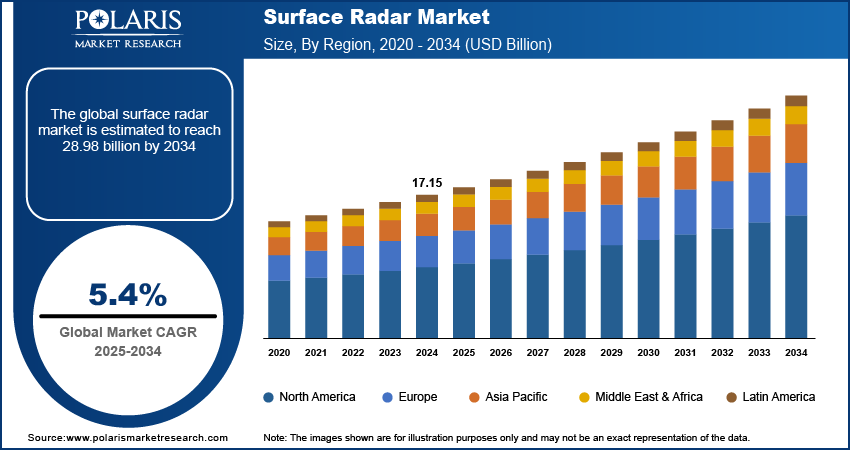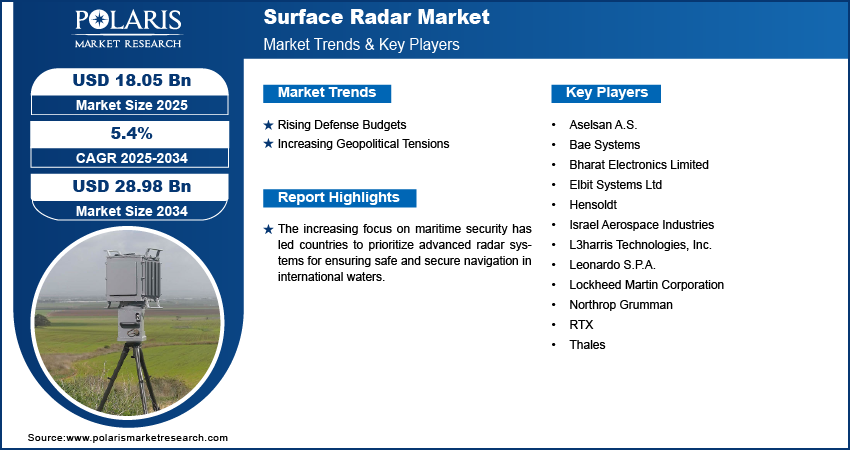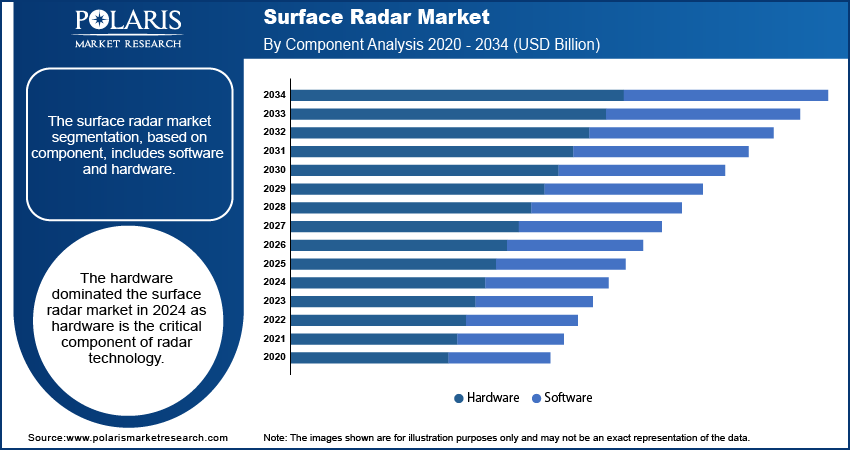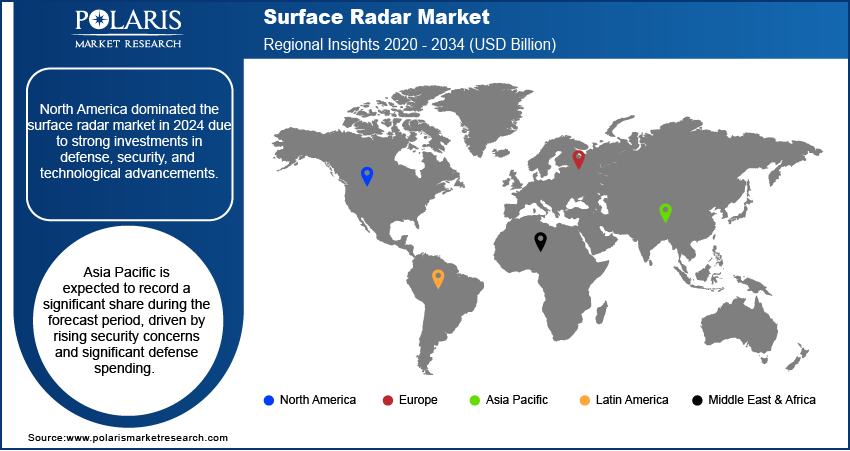
Surface Radar Market Size, Share, Trends, Industry Analysis Report: By Platform, Component (Hardware and Software), Range, Application, and Region (North America, Europe, Asia Pacific, Latin America, and Middle East & Africa) – Market Forecast, 2025–2034
- Published Date:Apr-2025
- Pages: 125
- Format: PDF
- Report ID: PM5515
- Base Year: 2024
- Historical Data: 2020-2023
Surface Radar Market Overview
The global surface radar market size was valued at USD 17.15 billion in 2024. The market is projected to grow from USD 18.05 billion in 2025 to USD 28.98 billion by 2034, exhibiting a CAGR of 5.4% from 2025 to 2034.
Surface radar is a type of radar system used to detect and track objects on or near the Earth's surface, such as vehicles, ships, or aircraft. It operates by emitting radio waves and analyzing the reflected signals to determine the position, speed, and movement of targets.
Technological improvements in radar systems are boosting their effectiveness and appeal. One of the biggest advancements is the development of phased array radar systems, which allow for faster and more accurate tracking of targets. These innovations improve the radar's ability to detect even small or low-flying objects with greater precision. New technologies, such as advanced signal processing and improved detection algorithms, are also making radar systems more powerful. The combination of these advancements makes modern surface radar systems more reliable, efficient, and capable, resulting in their increased adoption across both defense and commercial sectors, thereby driving the surface radar market growth.

To Understand More About this Research: Request a Free Sample Report
The increasing focus on maritime security has led countries to prioritize advanced radar systems for ensuring safe and secure navigation in international waters. Surface radars play a crucial role in detecting ships, vessels, and illegal activities like piracy, smuggling, or unauthorized fishing. Protecting vital shipping routes and offshore resources has become a top priority for many nations, driving investments in radar technologies for both military and commercial maritime operations. Additionally, growing concerns about territorial waters, especially in regions with significant economic or strategic importance, are fueling the demand for surface radars and propelling the surface radar market revenue.
Surface Radar Market Dynamics
Rising Defense Budgets
Many countries worldwide are increasing their defense budgets to strengthen their military capabilities due to rising security threats. They are investing heavily in advanced technologies, including surface radar systems, to improve national defense. For instance, according to the US Department of Defense, the US alone allocated USD 816.7 billion to the defense sector in 2022. Surface radar systems are critical for monitoring air, sea, and land threats. Nations are recognizing the importance of having a robust surveillance infrastructure to detect enemy movements, track vehicles, ships, and aircraft, and prevent possible attacks, thereby driving the surface radar market growth.
Increasing Geopolitical Tensions
Increased geopolitical tensions globally have led many countries to focus more on improving their defense and surveillance capabilities. Territorial disputes, cross-border conflicts, and rising concerns over national security are encouraging governments to invest in technologies like surface radar systems. According to the Vision of Humanity, 92 countries were involved in cross-border conflicts in 2024, the highest since the Second World War, driving the demand for surface radars. Additionally, political instability and growing security threats are intensifying the need for advanced radar systems to ensure safety and protection. Thus, rising geopolitical tensions globally are fueling the surface radar market development.

Surface Radar Market Segment Insights
Surface Radar Market Assessment by Range Outlook
The surface radar market assessment, based on range, includes long range, short range, medium range, and other. The short range is expected to witness the fastest growth from 2025 to 2034. Short-range radars are highly effective for tracking nearby targets, making them crucial for applications like border security, urban surveillance, and counter-drone operations. Their ability to provide real-time, high-precision monitoring in smaller, confined areas drives increased demand, especially in defense and security sectors. Rising security concerns in urban environments and along borders make the need for short-range radar systems more prominent, further contributing to the segment’s dominance in the market.
Surface Radar Market Evaluation by Component Outlook
The surface radar market evaluation, based on component, includes software and hardware. The hardware segment dominated the surface radar market in 2024. Hardware components such as antennas, receivers, transmitters, and signal processors are critical to the functioning of radar systems. These physical components are essential for detecting and tracking targets, and their quality directly impacts the radar's performance. Improvements in radar technology are fueling the need for advanced hardware, thereby driving segmental growth in the market.

Surface Radar Market Regional Analysis
By region, the study provides the surface radar market insights into North America, Europe, Asia Pacific, Latin America, and the Middle East & Africa. North America dominated the surface radar market in 2024 due to strong investments in defense, security, and technological advancements. The US, in particular, has a well-established defense sector, actively deploying surface radar systems for military, border security, and law enforcement purposes. Increased geopolitical tensions and technological innovations are driving demand for advanced radar solutions. The presence of leading radar manufacturers and defense contractors further contributes to the region’s leading market position.
Asia Pacific is expected to record a significant share during the forecast period, driven by rising security concerns and significant defense spending. Countries like China, Japan, South Korea, and India are investing heavily in advanced radar technologies for military and surveillance applications. Border security and maritime protection are further driving the demand for surface radars, particularly due to territorial disputes in areas like the South China Sea. Additionally, the region is seeing a rise in technological innovations, such as AI integration in radar systems, which are improving performance and driving the demand for surface radar systems in defense and commercial sectors, thereby driving the growth of the surface radar market in the Asia Pacific.
The India surface radar market is experiencing substantial growth. The country is modernizing its military infrastructure, with radar systems playing a crucial role in improving surveillance and security, particularly along its borders and coastal areas. The rising threat of cross-border conflicts and internal security issues has led to increased demand for advanced surface radar systems. India’s growing maritime trade and the need for better protection of critical resources are driving the adoption of radar technology, further contributing to the market growth in the country.

Surface Radar Market – Key Players and Competitive Insights
The surface radar market is constantly evolving, with numerous companies striving to innovate and distinguish themselves. Leading global corporations dominate the market by leveraging extensive research and development, and advanced techniques. These companies pursue strategic initiatives such as mergers and acquisitions, partnerships, and collaborations to enhance their product offerings and expand into new markets.
New companies are impacting the market by introducing innovative products to meet the demand of specific market sectors. This competitive environment is amplified by continuous progress in product offerings. Major players in the surface radar market include Aselsan A.S.; Bae Systems; Bharat Electronics Limited; Elbit Systems Ltd; Hensoldt; Israel Aerospace Industries; L3harris Technologies, Inc.; Leonardo S.P.A.; Lockheed Martin Corporation; Northrop Grumman; RTX; and Thales.
Lockheed Martin Corporation is a security and aerospace company formed by combining the businesses of Martin Marietta Corporation and Lockheed Corporation. The company engaged in diverse industry sectors, including research, development, design, integration, and manufacture of advanced technology products, systems, and services. The company provides a wide range of technical, scientific, engineering, management, information, and logistic services. Lockheed Martin serves the US and international markets with applications in civil, defense, and commercial industries. The multinational company has a strong presence across North America, Asia, Europe, and Australia. The company offers counter-drone solutions such as counter-drone swarms, Area Defense Anti-Munitions (ADAM) systems, and Lcarus. Lockheed Martin's business is divided into Aeronautics, Rotary and Mission Systems (RMS), Missiles and Fire Control (MFC), and Space. The Aeronautics segment is concerned with the study, planning, creation, production, installation, maintenance and support, service, and upgrading of sophisticated military planes, such as fighting and air transport aircraft, unmanned aircraft, as well as associated technologies. MFC segment offers air and missile protection structures, strategic missiles, air-to-ground accuracy attack weapon structures, logistic support, engineering services, mission management assistance, fire suppression systems, readiness, system integration, manned-unmanned surface vehicles, and power management alternatives. RMS segment designs, builds, assists, and upholds a wide range of surface vessels, commercial and military choppers, radar technologies, sea, and land-based rocket defense structures, sea and air-based task and battle systems, and command structures task remedies, internet strategies, and modeling and mentoring treatments. The space segment is involved in satellite R&D., designing, construction, manufacture, and tactical, sophisticated strike, and defense systems. The company offers 375+ facilities globally, with 100+ years of innovation. Lockheed Martin's ground-based air surveillance radars are multi-mission capable, detecting targets at any altitude. Chosen by over 30 nations, these high-performing, solid-state systems offer early warning and situational awareness and can operate in any environment.
L3 Technologies, in 2019, merged with Harris Corporation and was renamed to L3Harris Technologies. The company is a US-based focusing on detection systems, security, image intensification equipment, night vision intensification equipment, training, simulation, aircraft sustainment, and Intelligence, Surveillance, and Reconnaissance (ISR) systems. The company delivers end-to-end solutions to meet commercial and government customer's critical needs in over 100 countries. The company operates its business in four segments, including integrated mission systems, space & airborne systems, communication systems, and aviation systems. However, in January 2022, the company streamlined its business segments from four to three business segments, and therefore, the aviation system was eliminated from the segments of the company, and its operations were integrated among the operations of the other segments. Also, the company's integrated mission system comprises three sectors: marine, ISR, and electro-optical. Their ISR sector blends, creates, and sustains multi-mission ISR, fleet management support services, signals intelligence and communication systems, sensor development, modifications, and recurring depot maintenance for ISR and airborne missions. In contrast, the maritime sector is a producer, integrator, and sustainer of mission systems for naval platforms, specializing in signals intelligence and unmanned surface, multi-intelligence platforms, and autonomous underwater vehicles. The space & airborne system business unit of the company is further bifurcated into four sectors, including space, intel & cyber, mission avionics, and electronic warfare. They offer several products and solutions in these sectors, including avionic sensors, hardened electronics, release systems, situational awareness optical networks, advanced wireless solutions for classified intelligence and cyber defense customers, and many others. Aerojet Rocketdyne has been a part of L3Harris technologies since 2022. The SPS-48 is a modern, land-based surveillance radar system by L3Harris. It offers continuous, reliable operation in hostile environments, detecting and tracking diverse threats with high accuracy and low false alarms.
List of Key Companies in Surface Radar Market
- Aselsan A.S.
- Bae Systems
- Bharat Electronics Limited
- Elbit Systems Ltd
- Hensoldt
- Israel Aerospace Industries
- L3harris Technologies, Inc.
- Leonardo S.P.A.
- Lockheed Martin Corporation
- Northrop Grumman
- RTX
- Thales
Surface Radar Industry Developments
In August 2023, Nanoradar launched its new product, the WTC261-3000 water surface surveillance radar. This radar, part of the Aquatic Guardian series, offers advanced vessel detection and clutter suppression technology.
Surface Radar Market Segmentation
By Platform Outlook (Revenue, USD Billion, 2020–2034)
- Critical Infrastructure
- Vehicle-Mounted
- Shipborne
- Unmanned Surface Vehicles
- Others
By Component Outlook (Revenue, USD Billion, 2020–2034)
- Hardware
- Software
By Range Outlook (Revenue, USD Billion, 2020–2034)
- Long Range
- Short Range
- Medium Range
- Other
By Application Outlook (Revenue, USD Billion, 2020–2034)
- Surveillance
- Air Defense
- Perimeter Security
- Others
By Regional Outlook (Revenue, USD Billion, 2020–2034)
- North America
- US
- Canada
- Europe
- Germany
- France
- UK
- Italy
- Spain
- Netherlands
- Russia
- Rest of Europe
- Asia Pacific
- China
- Japan
- India
- Malaysia
- South Korea
- Indonesia
- Australia
- Rest of Asia Pacific
- Middle East & Africa
- Saudi Arabia
- UAE
- Israel
- South Africa
- Rest of Middle East & Africa
- Latin America
- Mexico
- Brazil
- Argentina
- Rest of Latin America
Surface Radar Market Report Scope
|
Report Attributes |
Details |
|
Market Size Value in 2024 |
USD 17.15 billion |
|
Market Size Value in 2025 |
USD 18.05 billion |
|
Revenue Forecast by 2034 |
USD 28.98 billion |
|
CAGR |
5.4% from 2025–2034 |
|
Base Year |
2024 |
|
Historical Data |
2020–2023 |
|
Forecast Period |
2025–2034 |
|
Quantitative Units |
Revenue in USD billion and CAGR from 2025 to 2034 |
|
Report Coverage |
Revenue Forecast, Market Competitive Landscape, Growth Factors, and Trends |
|
Segments Covered |
|
|
Regional Scope |
|
|
Competitive Landscape |
|
|
Report Format |
|
|
Customization |
Report customization as per your requirements with respect to countries, regions, and segmentation. |
FAQ's
The surface radar market size was valued at USD 17.15 billion in 2024 and is projected to grow to USD 28.98 billion by 2034.
The global market is projected to register a CAGR of 5.4% during the forecast period.
North America had the largest share of the global market in 2024.
A few of the key players in the market are Aselsan A.S.; Bae Systems; Bharat Electronics Limited; Elbit Systems Ltd; Hensoldt; Israel Aerospace Industries; L3harris Technologies, Inc.; Leonardo S.P.A.; Lockheed Martin Corporation; Northrop Grumman; RTX; and Thales.
The hardware segment dominated the surface radar market in 2024, as hardware is the critical component of radar technology.
The short range segment is expected to witness the fastest growth during the forecast period due to rising demand for short-range surface radar, driven by rising urban tensions.
